Milestones in Catholic Education
1842-2018
1842
Father Martin Kundig established the first Catholic school for girls on Jefferson and E. State Street and the first school for boys in the basement of St. Peter’s Church, Milwaukee.
1846
The Daughters of Charity took over the girls’ school in Milwaukee and opened their own academy to Catholics and non-Catholics.
1847
Fr. Samuel Mazzuchelli, an early missionary, opened a Catholic school at Sinsinawa Mound. The Dominican Sisters of Sinsinawa, founded by Mazzuchelli, were the first Wisconsin-based sisterhood to open a Catholic school.
1851
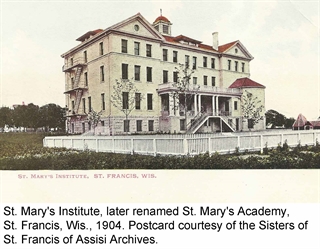 The School Sisters of Notre Dame, one of the largest and most influential of the German sisterhoods in Wisconsin, began their history of extensive service to Catholic schools by establishing early schools in Milwaukee (1851), Port Washington (1857), Kenosha (1858), Sheboygan (1858), Burlington (1860), Beaver Dam (1862), and St. Kilian (1867). During these early years, many schools were begun with lay teachers but switched over to religious communities of women. Notable foundresses and founders of Catholic education in the Archdiocese included Mother Antonia Zimmer, OSF; Mother Caroline Friess, SSND; Mother Benedicta Bauer, OP; Father Samuel Mazzuchelli and Mother Emily Power, OP; Father Caspar Rehrl and Mother Agnes Hazotte, CSA; and Father Francis Haas, OFM Cap. Not only were the origins of many women’s religious communities closely connected to the establishment of Catholic schools, but these sisterhoods created the framework of the major system of Catholic schools that came to exist in the archdiocese and in the state.
The School Sisters of Notre Dame, one of the largest and most influential of the German sisterhoods in Wisconsin, began their history of extensive service to Catholic schools by establishing early schools in Milwaukee (1851), Port Washington (1857), Kenosha (1858), Sheboygan (1858), Burlington (1860), Beaver Dam (1862), and St. Kilian (1867). During these early years, many schools were begun with lay teachers but switched over to religious communities of women. Notable foundresses and founders of Catholic education in the Archdiocese included Mother Antonia Zimmer, OSF; Mother Caroline Friess, SSND; Mother Benedicta Bauer, OP; Father Samuel Mazzuchelli and Mother Emily Power, OP; Father Caspar Rehrl and Mother Agnes Hazotte, CSA; and Father Francis Haas, OFM Cap. Not only were the origins of many women’s religious communities closely connected to the establishment of Catholic schools, but these sisterhoods created the framework of the major system of Catholic schools that came to exist in the archdiocese and in the state.
1856
Father Caspar Rehrl, with the Sisters of St. Agnes, founded Barton School in West Bend. Later renamed St. Mary Parish School, it was the longest continually operated Catholic school in Wisconsin and the third longest in the nation when it closed in 2016.
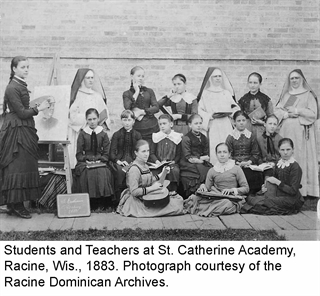 1864
1864
St. Catherine’s Academy was founded by the Racine Dominicans as an all-girls’ school. In 1924, it became the first coeducational high school in the archdiocese.
1881
Marquette College opened as a small liberal arts college for men. It later became Marquette University.
1884
The Third Plenary Council of Baltimore decreed that every parish was to have a school and that parents were obliged to send their children to these parochial schools unless exempted by the pastor. While German-speaking parents had favored Catholic schools, English-speaking had considered public schools adequate. Milwaukee Archbishop Michael Heiss promulgated this mandate.
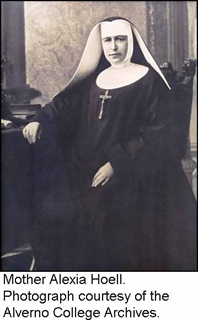 1887
1887
Mother M. Alexia Hoell established St. Joseph Normal School to educate future teachers within the School Sisters of St. Francis community. This school eventually became Alverno College.
1888
St. Joseph Convent, motherhouse of the School Sisters of St. Francis from Germany, was dedicated. The SSSF’s provided significant numbers of teaching sisters for the Catholic schools, exceeded only by the SSND’s.
1889
The Bennett Law required compulsory education for children between ages 7 – 14. Wisconsin bishops protested this law, arguing that the right to educate resided with parents and the Church.
1890
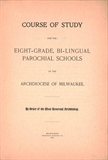 Following national and local controversies regarding the relationship between public and Catholic school financing and facilities usage, e.g., the Poughkeepsie Plan and the Faribault-Stillwater Plan, Archbishop Frederick Katzer authorized increased establishment of combined church and school buildings in the archdiocese. An archdiocesan Catholic school system was born, and an archdiocesan “Course of Studies” to standardize the schools’ curriculum was drafted. The curriculums were written for English, German, Polish and Bohemian languages.
Following national and local controversies regarding the relationship between public and Catholic school financing and facilities usage, e.g., the Poughkeepsie Plan and the Faribault-Stillwater Plan, Archbishop Frederick Katzer authorized increased establishment of combined church and school buildings in the archdiocese. An archdiocesan Catholic school system was born, and an archdiocesan “Course of Studies” to standardize the schools’ curriculum was drafted. The curriculums were written for English, German, Polish and Bohemian languages.
1895
Based on the mandate of the Third Plenary Council of Baltimore, the two gender-separated schools at the Cathedral of St. John were combined and eventually taken over by the Sinsinawa Dominicans. The Daughters of Charity previously had taught the girls.
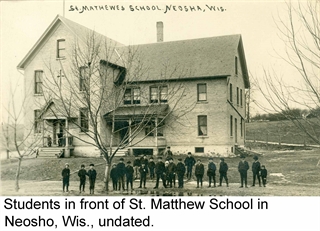 1868 - 1903
1868 - 1903
As a result of immigration, the Catholic population of the Archdiocese grew from 180,000 - 240,000. The expansion of Catholic schools by religious communities of women was largely based on schools’ ethnic populations; e.g., the School Sisters of Notre Dame attended to German schools; the Sinsinawa Dominicans, many English-speaking parish schools; the Racine Dominicans, the schools of Racine and the Fox River Valley; the School Sisters of St. Francis, German and English schools; the Felicians, Polish schools, the Sisters of St. Agnes, schools in the Fond du Lac and West Bend areas, and the Salvatorians, English-speaking schools.
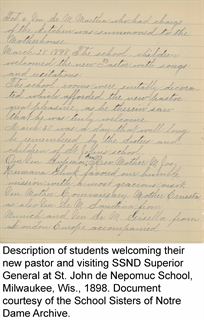 1900 - 1940
1900 - 1940
The Catholic school network in the archdiocese grew stronger and more unified. Frequently schools were built before parish churches. Religious communities appointed senior sisters to supervise the teaching of the young, generally untrained sister-teachers.
1902
Archbishop Katzer called for the formation of a new archdiocesan school board.
1904
The Catholic Education Association (CEA), later the NCEA, was established to professionalize Catholic schools and teacher training.
1921
Father Joseph Barbian was appointed by Archbishop Sebastian Messmer as the first superintendent of schools for the archdiocese.
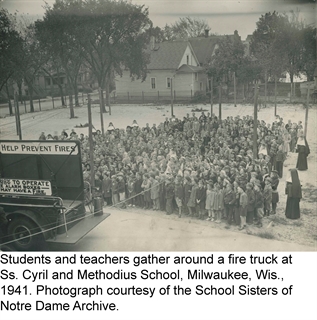 1925
1925
Marquette University High School was opened on 24th and Wisconsin. Many of the high schools, such as MUHS, St. Mary’s Academy, and St. Catherine’s Racine, began as academies.
1929
Pius XI High School was founded as a parish school under the direction of the Pallottine Fathers and the School Sisters of St. Francis. As a diocesan school in the 1960’s, with an enrollment of over 2,000 students, it was the largest Catholic high school in Wisconsin.
The School Sisters of Notre Dame opened Mount Mary University in Milwaukee.
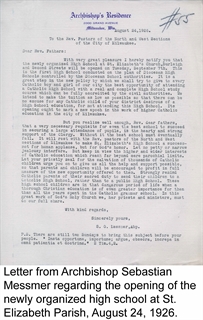 1930
1930
Messmer High School, the first diocesan high school, was opened on 8th and Capitol Dr. The school originated at St. Elizabeth, but in 1930 opened in it's present location. By the early 1940’s, it was running double shifts of classes to accommodate student demand.
1936
The Congregation of Sisters of St. Agnes opened Marian College, later Marian University, in Fond du Lac.
1937
Msgr. Edmund Goebel was appointed by Archbishop Samuel Stritch as Milwaukee’s second superintendent. His tenure lasted until 1970 and included the expansion of central office staff, his personal authoring of a series of Catholic textbooks, archdiocesan standardized tests administered semi-annually to grade school students, required teacher certification, an archdiocesan television network, and an annual teachers’ convention.
Cardinal Stritch University opened.
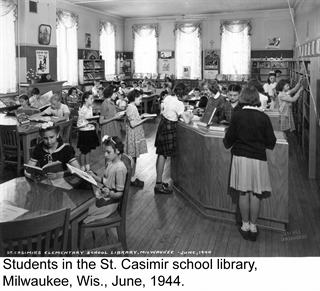 1948
1948
Catholic Memorial High School in Waukesha was founded, the first Catholic high school to be built since Messmer in 1930.
1962
Vatican Council II was convened by Pope John XXIII.
1963 - 1964
Catholic education in the archdiocese was at its high point, with 100,733 students in 1963 and 235 schools in 1964. In 1964, 2,720 sisters served the schools, representing 29 religious communities. The School Sisters of Notre Dame administered 54 schools in the early 1960’s, and the School Sisters of St. Francis directed 50.
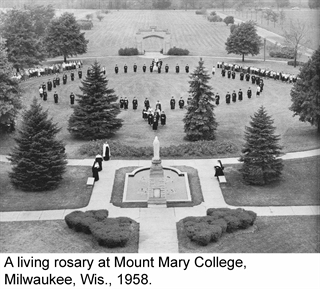 1967
1967
Primarily for financial reasons, the precipitous decline in Catholic school enrollment began.
1968
Milwaukee Archdiocesan Elementary Principals’ Association (MAEPA) was formed.
1969
Consolidated Parochial Elementary School (CPES) in rural Fond du Lac County (now Holyland Catholic) and Rosemary School in Ozaukee County (now Divine Savior) were founded. Followed several years later by Unified Catholic Parish Schools of Beaver Dam (now St. Katharine Drexel School), they remain the oldest of the many formal school consolidations now operational in the archdiocese.
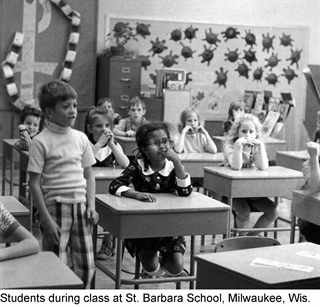 1971
1971
Father John Hanley was appointed superintendent of Catholic schools by Archbishop William Cousins and served in this capacity until 1984.
1970’s – 1980’s
Legislation allowed government aid to benefit Catholic schools through programs such as Project Head Start, bus transportation, books, materials, and hot lunches. Lay teachers in schools increased, and enrollments continued to decrease. Schools’ Planning and Accreditation (SPA) for Catholic elementary schools in the Archdiocese of Milwaukee began. School boards, advisory councils, and committees started to take hold in both elementary and secondary schools.
1974
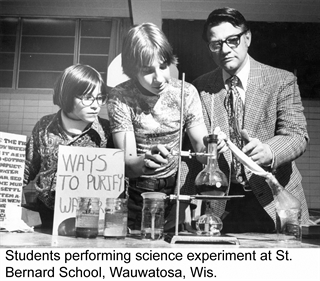 An annual National Catholic Schools Week was instituted and promulgated by the NCEA as part of the initial marketing campaigns on behalf of Catholic education.
An annual National Catholic Schools Week was instituted and promulgated by the NCEA as part of the initial marketing campaigns on behalf of Catholic education.
1975
Total Catholic school enrollment in the archdiocese had decreased by almost 50% since 1965. A total of 60 schools had closed or consolidated in that time period. Only 33% of the Catholic school teachers were from religious communities.
1990
Milwaukee’s Parental Choice Program, considered to be the nation’s first modern private school choice program, was enacted and launched.
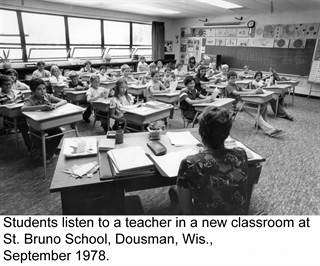 1994
1994
St. Rose Urban Academy and St. Leo Catholic Academy were formed and were managed by the Archdiocese of Milwaukee.
2007
Messmer Catholic Schools assumed management of St. Rose and St. Leo Urban Academies at the request of the archdiocese.
2008
The Greater Milwaukee Catholic Education Consortium (GMCEC), the collaborative entity formed by the five institutions of Catholic higher education in the Archdiocese of 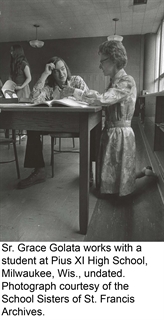 Milwaukee, was founded to support Catholic PK-12 schools in the archdiocese by sharing their academic resources and professional expertise.
Milwaukee, was founded to support Catholic PK-12 schools in the archdiocese by sharing their academic resources and professional expertise.
2011
The Racine Parental Choice Program began.
2011
Sustaining the Mission, the formal religious education certification program for Catholic school personnel in the archdiocese, sponsored by the Saint Clare Center at Cardinal Stritch University, was instituted and promulgated.
2013
The statewide Wisconsin Parental Choice Program began. Currently 59% of archdiocesan Catholic schools participate in one or more of the state’s Choice (voucher) programs.
 2015
2015
Cristo Rey High School, sponsored by the Society of Jesus and the newest Catholic high school in the archdiocese, was founded.
2016
Seton Catholic Schools was founded: a network of 11 urban Catholic elementary schools in the city of Milwaukee.
2017
Siena Catholic Schools, a network of five elementary schools and St. Catherine’s High School in Racine, was announced.
2018
Total Catholic school enrollment is 30,104 students, in 92 elementary schools and 15 high schools. Student ethnicity is currently 54.2% Caucasian, 25.8% Hispanic, 12.6% African-American, 3.7% Multiracial, and 3.8% Asian and other. 14% of current students are non-Catholic. Of the 2500 teachers and administrators employed by the Catholic schools of the archdiocese today, less than 1% are priests and religious. Two (2) priests are Catholic school administrators. All other administrators are lay women and men.
The Archdiocese of Milwaukee ranks 12th in the United States among all archdioceses/dioceses in Catholic school enrollment and 9th in total number of schools.
By: Kathleen Cepelka, Superintendent of Catholic Schools
Photographs and documents courtesy of the Archdiocese of Milwaukee Archives, unless otherwise noted. Photographs and documents cannot be reproduced without prior written authorization. For permission to reproduce contact the archdiocesan archives.